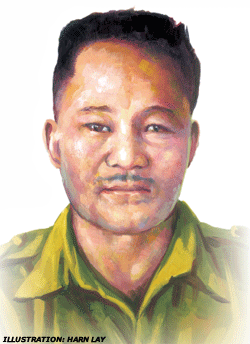Heroes and Villains
(Page 3 of 6)
In November 1978, Let Ya was killed in action during a skirmish with Karen troops near the Thai border.
—Aung Zaw
------------------------------------------------------------
A Living Comrade
Brig-Gen Kyaw Zaw (1919- )
 |
Kyaw Zaw distinguished himself in the Battle of Insein in 1949, during which he repelled an attack by Karen rebels who had captured the northern suburbs of Rangoon. He described the more than three-month campaign in his autobiography as “unforgettable—the longest fight of my military career,” and “the most difficult, exhausting and dangerous” battle he had ever experienced. His former officers and soldiers in the battle remembered him as a brave commander who always fought alongside his troops.
After Burma gained independence in 1948, Kyaw Zaw became a household name for his leadership in fending off invading Chinese Kuomintang forces in Shan State. His exploits along the Thai-Burmese border have passed into legend. He is said to have secured an agreement from a Thai general, who was swindled in an opium deal with the KMT, to allow his troops, artillery and air support to pursue the KMT across the Thai border.
While preparing his attack on Doi Tung, the KMT’s mountainous stronghold near the Thai-Burmese border, Kyaw Zaw was asked by a Thai liaison officer friendly with the Chinese forces how long it would take to capture the base. “If we attack at 8 a.m., our flag will fly over their base no later than 4 p.m.,” he replied. More than 10,000 spectators are said to have gathered on the Thai side of the border to watch the attack, with some even wagering money on the outcome. Kyaw Zaw kept his word, and the Burmese flag flew by 4 p.m.
In April 1957, Kyaw Zaw’s luck turned. He was forced to retire after documents recovered from raids at a CPB stronghold in central Burma showed that he may have provided information about Burmese troop movements to the communist insurgents. After retirement, he actively supported the People’s Peace Committee, which called for an end to civil war in Burma. To escape surveillance by the government, he went to CPB-controlled territory in 1976 and rejoined the party as a member of the central committee and military commission. When internal rivalries divided the party in 1989, he fled to China.
Now 88 years old, the veteran commander lives in exile in Kunming, China. In an interview with The Irrawaddy, he described today’s Tatmadaw as “a professional mercenary army.” He said that, unlike himself and military leaders of his generation who fought solely for their country, “The only aim of today’s army leaders is to protect and maintain the military dictatorship.”
—Yeni
------------------------------------------------------------
The ‘Four-foot Colonel’
Gen Smith Dun (1906-1979)
 |
The diminutive colonel—an ethnic Karen—received his training at the Indian Military Academy, where he won the first Sword of Honor (given to the best cadet in each year’s intake), and later helmed a contingent of Karen guerrilla forces from the Irrawaddy delta during World War II.
Smith Dun played a key role in the early years of Burma’s independence. He was appointed head of Burma’s armed forces and promoted to the rank of general in a move agreed to by ethnic parties and Burmese nationalists to foster confidence in a future Burmese union that would include all ethnic minority groups.
That confidence was shaken in 1949 when the Karen began their war for independence from Burma. Smith Dun was sacked, along with his fellow Karen troops, and replaced by a man who would later have a dramatic and lingering impact on the nation: Gen Ne Win.
Despite a strong sense of his Karen ethnicity, Smith Dun had always been a loyal and professional leader of the Burmese army. As its commander, he kept his Karen soldiers sharp and disciplined. Suspicion of his ethnic roots, however, lingered even after his dismissal.
« previous 1 | 2 | 3 | 4 | 5 | 6 next page »
